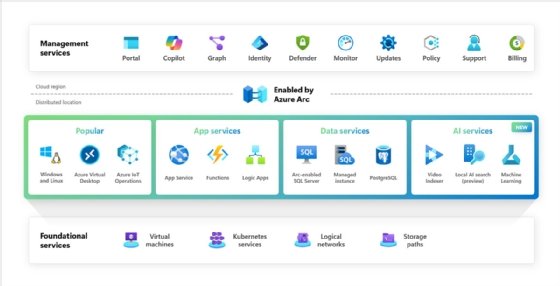Microsoft launches Azure Local for Hybrid Cloud, edge uses
Along with Azure Local, Microsoft has launched a migration tool for enterprises that want to ditch their VMware by Broadcom VMs.
Microsoft has launched cloud-connected software that lets companies run Azure computing, networking, storage and application services in an edge location or hybrid cloud environment.
Microsoft introduced Azure Local at the Ignite conference Tuesday in Chicago. The infrastructure software, which can run on more than 100 validated hardware platforms, is generally available. Companies using hybrid cloud-builder Azure Stack HCI will get Azure Local as a replacement through an automatic update.
Azure Local uses the Azure portal to deploy, configure, update and monitor Azure cloud resources, including APIs. The local management tools provide a unified approach to cloud resources across distributed locations.
Enterprises want to replicate their public cloud computing environments on-premises to keep sensitive data in-house for security, sovereignty and reliability reasons, said Jim Frey, an analyst at TechTarget's Enterprise Strategy Group. Microsoft's cloud rivals already provide products similar to Azure Local.
"It's great to see Microsoft Azure responding to the needs for on-premises deployment of cloud-connected and cloud-oriented application infrastructure in ways that the other major cloud providers have already done," Frey said.
During his Ignite keynote, Microsoft CEO Satya Nadella acknowledged the high customer demand for a product like Azure Local.
"This is something that many of you have asked us to do," he said.
The first step in using Azure Local is to connect the machine it's running on to Azure Arc, a tool for managing resources across data centers, edge and multi-cloud environments. From there, Arc deploys an Azure Local instance on the hardware.
IT can customize Azure Local's computing, networking and storage services. Microsoft packages the software as an Azure Arc extension and stores a template of the installation on Azure Resource Manager to deploy at other locations.
Microsoft provides monthly local updates for the entire infrastructure stack and drivers and firmware for the validated hardware. Manufacturers providing Azure Local devices include Dell, Hewlett Packard Enterprise and Lenovo.
IT staff can view and choose to deploy Azure Local updates within Azure Update Manager. Azure Local moves workloads and updates to each physical machine sequentially to ensure applications continue running, said Cosmos Darwin, group product manager for Azure distributed infrastructure, in a blog.
Azure Local integrates with Azure Monitor, a monitoring service that provides observability across applications, infrastructure and networks in Azure and on-premises environments enabled by Azure Arc. Azure Monitor covers distributed virtual machines (VMs), Kubernetes container clusters and physical infrastructure.

Migrate VMware to Local
Microsoft introduced Azure Migrate in preview for enterprises that want to switch their VMware by Broadcom VMs to Azure Local. IT staff would use the Azure portal and APIs to copy and convert a VMware VM disk to an on-premises Azure Local VM. The migration shares only metadata with the Azure Cloud.
"This may enable you to reduce your Broadcom footprint and licensing without costly app rewrites," Darwin said.
Broadcom completed the $69 billion acquisition of VMware in November 2023 and later switched pricing from an on-premises model to subscription-based licensing. The switch reportedly raised pricing by as much as 300% for some customers.
For developers, every Azure Local instance includes the Azure Kubernetes Service (AKS), an orchestration service for Kubernetes container clusters. Microsoft automatically updates AKS with each Azure Local update.
Microsoft plans to release a lightweight version of Azure Local next year for deployment on rugged industrial hardware in remote locations. The instance will allow companies to connect multiple devices to a 1 Gbps Ethernet network, eliminating the need for high-speed switching.
Antone Gonsalves is an editor at large for TechTarget Editorial, reporting on industry trends critical to enterprise tech buyers. He has worked in tech journalism for 25 years and is based in San Francisco. Have a news tip? Please drop him an email.







